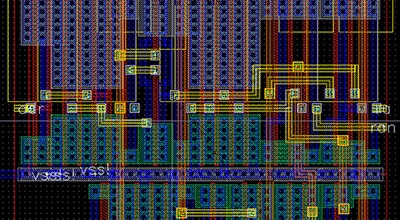Verilog Concatenation - Part 11 of our Verilog Series
2024-03-11 | By DWARAKAN RAMANATHAN
What is Verilog Concatenation?
In Verilog, concatenation is the process of combining multiple signals, vectors, or values to create a larger signal or vector. It's a fundamental operation used in digital hardware design to build more complex data structures or connect different signals together.
The concatenation operator in Verilog is denoted by {} (curly braces). You can use this operator to concatenate signals or values in a specified order. Here's the basic syntax:
{signal1, signal2, signal3, ...}
- signal1, signal2, signal3, and so on, represent the signals or values you want to concatenate.
For example, if you have two 4-bit signals, signal_a and signal_b, you can concatenate them into an 8-bit signal like this:
{signal_a, signal_b}
The resulting signal will be 8 bits long, with signal_a occupying the most significant bits (leftmost) and signal_b occupying the least significant bits (rightmost).
Concatenation is widely used for various purposes in Verilog, including:
- Building wider data buses by combining narrower buses.
- Creating complex data structures or custom data types.
- Connecting multiple signals or values together.
- Constructing address or control signals for memory access and control.
- Formatting data for output or display.
Understanding how to use concatenation is crucial for designing and manipulating signals effectively in Verilog hardware descriptions.
Beginner Level Example:
Suppose you are designing a memory subsystem for a computer system, and you have the following components of an address:
- module_id (2 bits): Identifies the memory module within the system.
- block_number (6 bits): Specifies the memory block within the module.
- word_offset (4 bits): Indicates the offset within the memory block for a specific word.
Now, you need to concatenate these components to create the complete memory address before accessing data from memory.
Here's how you can use Verilog concatenation to achieve this:
module memory_controller (
input [1:0] module_id,
input [5:0] block_number,
input [3:0] word_offset,
output [13:0] memory_address );
assign memory_address = {module_id, block_number, word_offset};
endmodule
In this Verilog module:
- module_id is a 2-bit input representing the memory module.
- block_number is a 6-bit input specifying the memory block within the module.
- word_offset is a 4-bit input indicating the offset within the memory block for a specific word.
- memory_address is a 14-bit output that represents the complete memory address.
The concatenation operation {module_id, block_number, word_offset} combines these three components to form the memory_address. For example, if module_id is 2'b01, block_number is 6'b110011, and word_offset is 4'b1010, the resulting memory_address will be 14'b01100110101010.
This constructed memory address can then be used to access data from the memory module specified by module_id, block block_number, and the word offset word_offset. This real-time example demonstrates how Verilog concatenation is applied practically in designing hardware for addressing memory locations.
Advanced Level Example:
Suppose you are designing the control unit for a microprocessor, and you have several control signals that need to be combined into a single control word. These control signals include:
- ALUOp (4 bits): Specifies the operation for the Arithmetic Logic Unit (ALU).
- RegDst (2 bits): Selects the destination register for write-back.
- MemRead (1 bit): Signals whether a memory read operation is required.
- MemWrite (1 bit): Signals whether a memory write operation is required.
- MemToReg (1 bit): Specifies whether the data should be written to a register from memory.
- ALUSrc (1 bit): Selects the second ALU operand from either a register or an immediate value.
- RegWrite (1 bit): Indicates whether a register write operation should be performed.
Now, you want to concatenate these control signals into a 16-bit control word, where each control signal occupies a specific portion of the word.
Here's how you can use Verilog concatenation to create the control word:
module control_unit (
input [3:0] ALUOp,
input [1:0] RegDst,
input MemRead,
input MemWrite,
input MemToReg,
input ALUSrc,
input RegWrite,
output reg [15:0] control_word );
always @* begin control_word = {ALUOp, RegDst, MemRead, MemWrite, MemToReg, ALUSrc, RegWrite};
end
endmodule
In this Verilog module:
- ALUOp is a 4-bit input representing the ALU operation code.
- RegDst is a 2-bit input specifying the destination register.
- MemRead, MemWrite, MemToReg, ALUSrc, and RegWrite are single-bit inputs representing various control signals.
- control_word is a 16-bit output that represents the combined control word.
The {ALUOp, RegDst, MemRead, MemWrite, MemToReg, ALUSrc, RegWrite} concatenation combines these control signals into a single 16-bit control word. This control word can be used to control various aspects of the microprocessor's execution, including ALU operations, register selection, and memory operations.
This advanced example showcases how Verilog concatenation can be used to build complex control words for controlling the behavior of a microprocessor's control unit. It illustrates the power and flexibility of Verilog for designing intricate digital systems.
An Alternative Approach:
There are alternative ways to create a control word in Verilog, and one common approach is to use a case statement to map specific control signals to their respective positions within the control word. Here's an example using this approach:
module control_unit (
input [3:0] ALUOp,
input [1:0] RegDst,
input MemRead,
input MemWrite,
input MemToReg,
input ALUSrc,
input RegWrite,
output reg [15:0] control_word );
always @* begin
case ({ALUOp, RegDst, MemRead, MemWrite, MemToReg, ALUSrc, RegWrite})
16'b0000000: control_word = 16'b0000000000000000; // Default case // Add more cases to map specific control signal combinations to the control word.
16'bxxxxxxx: control_word = 16'bzzzzzzzzzzzzzzzz; // Handle unspecified cases
endcase
end
endmodule
In this alternative approach:
- The case statement is used to evaluate the combination of control signals represented by {ALUOp, RegDst, MemRead, MemWrite, MemToReg, ALUSrc, RegWrite}.
- Inside the case statement, specific cases are defined to match known combinations of control signals. You can use the 16-bit binary values (e.g., 16'b0000000) to represent specific combinations and assign corresponding control words.
- A default case is provided to handle any unspecified combinations.
- The xxxxxxx and zzzzzzzzzzzzzzzz placeholders represent don't-care values.
This alternative approach allows you to explicitly specify the control word for each known combination of control signals while providing a default case for unspecified or unexpected combinations. It can make the code more readable and easier to maintain when dealing with complex control units in microprocessor design.
















